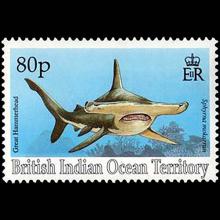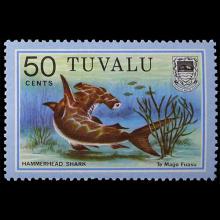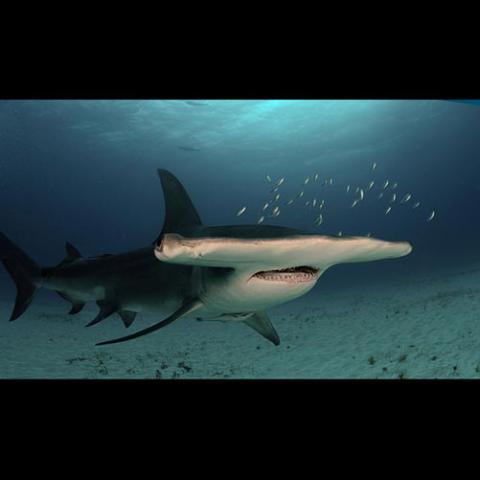NAMES
TAXONOMY
British Indian Ocean Territory
Issued:
Stamp:
Sphyrna mokarran
Tuvalu
Issued:
Stamp:
Sphyrna mokarran
British Indian Ocean Territory
Issued:
Stamp:
Sphyrna mokarran
Tuvalu
Issued:
Stamp:
Sphyrna mokarran
British Indian Ocean Territory
Issued:
Stamp:
Sphyrna mokarran
Tuvalu
Issued:
Stamp:
Sphyrna mokarran
Genus species (Animalia): Sphyrna mokarran
The great hammerhead (Sphyrna mokarran) is the largest species of hammerhead shark, belonging to the family Sphyrnidae, attaining a maximum length of 6.1 m (20 ft). It is found in tropical and warm temperate waters worldwide, inhabiting coastal areas and the continental shelf. The great hammerhead can be distinguished from other hammerheads by the shape of its "hammer" (called the "cephalofoil"), which is wide with an almost straight front margin, and by its tall, sickle-shaped first dorsal fin. A solitary, strong-swimming apex predator, the great hammerhead feeds on a wide variety of prey ranging from crustaceans and cephalopods, to bony fish, to smaller sharks. Observations of this species in the wild suggest that the cephalofoil functions to immobilize stingrays, a favored prey. This species has a viviparous mode of reproduction, bearing litters of up to 55 pups every two years.
Although potentially dangerous, the great hammerhead rarely attacks humans. It sometimes behaves inquisitively toward divers and should be treated with respect. This shark is heavily fished for its large fins, which are extremely valuable on the Asian market as the main ingredient of shark fin soup. As a result, great hammerhead populations are declining substantially worldwide, and it has been assessed as Endangered and change to Critically Endangered by the International Union for Conservation of Nature (IUCN).



